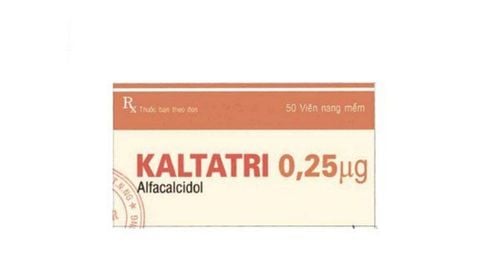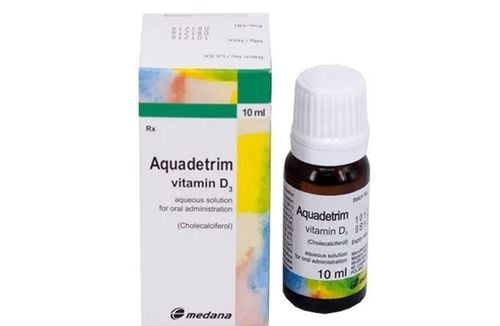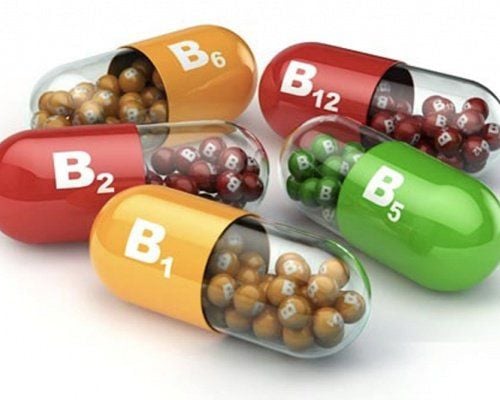This is an automatically translated article.
Ometadol medicine has the main ingredient Alfacalcidol 0.25mcg belonging to the group of vitamins and minerals. The drug is indicated in diseases caused by disorders of calcium metabolism leading to decreased endogenous synthesis of 125-dihydroxy vitamin D3. To use the drug effectively, patients should refer to the information on ingredients and usage in the following article.
1. What is Ometadol?
What does Ometadol do? Ometadol medicine has the main ingredient Alfacalcidol 0.25mcg belonging to the group of vitamins and minerals. The drug is prepared in the form of soft capsules, packed in a box of 10 blisters x 10 tablets.The drug is indicated in diseases caused by disorders of calcium metabolism leading to decreased endogenous synthesis of 125-dihydroxy vitamin D3.
2. Indications and contraindications to the use of Ometadol
What does Ometadol do? Ometadol is indicated in the following cases:2.1. Indications Thanks to the active ingredient, Ometadol is indicated for the treatment of diseases caused by disorders of calcium metabolism. This leads to a decrease in endogenous synthesis of 125-dihydroxy vitamin D3, specifically:
Renal osteodystrophy Treatment of hypoparathyroidism after surgery, spontaneous pseudohypoparathyroidism Rickets, Vitamin D-resistant osteomalacia Vitamin D-dependent rickets Treatment of hypocalcemia or neonatal rickets Calcium malabsorption Postmenopausal osteoporosis 2.2. Contraindications Ometadol is contraindicated in patients with hypercalcemia
3. Dosage and how to use Ometadol
Ometadol is made in the form of a soft capsule that should be taken orally.
Dosage of Ometadol will be considered and adjusted based on the patient's blood calcium levels. Accordingly, the dosage of Ometadol is specifically indicated as follows:
Adults and children over 20 kg: (Sick dose / daily use)
Renal dystrophy: 0.5 -1μg
Hypoparathyroidism, pathology due to abnormal vitamin D metabolism
Adults: 1.0 – 4.0μg Children: 0.01 – 0.03μg Postmenopausal osteoporosis 1μg: Maintenance dose: 0.25μg – 1μg daily.
Elderly people: 0.5 μg/day
It should be noted: The above dosage is for reference only, patients need to take the drug according to the instructions of the doctor who has prescribed it to ensure effective treatment and avoid unwanted side effects.
4. Ometadol drug interactions
During the use of Ometadol, the following drug interactions may occur:
Glycoside digitalis: When used together in patients with hypercalcemia, digitalis may cause confusion. arrhythmia . Therefore, patients need to be careful when using digitalis with Ometadol at the same time. Barbiturates, Anticonvulsants and Enzyme Inducers: In patients receiving barbiturates or enzyme-inducing anticonvulsants, the dose of Alfacalcidol should be increased to achieve the desired results. Drugs that affect intestinal absorption: The absorption of the active ingredient Alfacalcidol may be impaired when used concomitantly with mineral oil, cholestyramine, sucralfate colestiopol, or large amounts of aluminum-containing antacids. Magnesium: Patients should be careful when using magnesium-containing antacids, laxatives in patients with prolonged hemodialysis who are being treated with the active ingredient Alfacalcidol. Accordingly, hypermagnesemia may occur. Calcium/Thiazide: When Alfacalcidol is used in combination with calcium-containing preparations or Thiazide diuretics, it may increase blood calcium. Vitamin D and derivatives: Active ingredient Alfacalcidol is the main derivative of Vitamin D. Therefore, Alfacalcidol should not be combined with vitamin D or its derivatives. Because this is likely to increase the effect of the drug, thereby leading to the risk of hypercalcemia.
5. Ometadol side effects
The active ingredient Alfacalcidol contained in Ometadol is usually easily tolerated. However, during use, patients may also experience some side effects, for example: hypercalcemia. When experiencing this side effect, the patient can be corrected by stopping the drug until the calcium level in the blood is back to normal.In addition to the side effect of increasing blood calcium, patients may also experience some other side effects such as: loss of appetite, nausea, vomiting, diarrhea, constipation, abdominal cramps, stomach pain, itching, rash , conjunctival congestion, increased GPT, GOT, LDH and y-GOT.
During the use of Ometadol, if a patient encounters any side effects, they should notify their doctor so that the doctor can promptly adjust, consider, and avoid side effects that affect their health. .
6. Notes when using Ometadol
During the use of Ometadol, the patient should pay attention to the following issues:
During the use of the drug, the patient should check the serum calcium concentration regularly. In addition, the dose should also be adjusted so that the serum calcium concentration does not exceed the normal range. Elderly: Use caution when using Ometadol in the elderly, because the body functions of the elderly have gradually weakened. Children: The treatment of children with active ingredient Alfacalcidol should be adjusted from a low dose, then gradually increased. Pregnant and lactating women: To ensure the safety of the health of the mother, the fetus, as well as the nursing baby, patients should only use Ometadol when consulted and prescribed by a doctor. Store Ometadol in a cool, dry place, out of reach of children and family pets. Before using the medicine, check the expiry date. If the drug shows signs of watery, distorted, the patient should not use it. Consult environmental companies for methods of disposing of drugs.
Ometadol medicine has the main ingredient Alfacalcidol 0.25mcg belonging to the group of vitamins and minerals. The drug is indicated in diseases caused by disorders of calcium metabolism leading to decreased endogenous synthesis of 125-dihydroxy vitamin D3. To ensure effective use, patients need to carefully read the instructions, and consult a doctor or pharmacist for advice.













